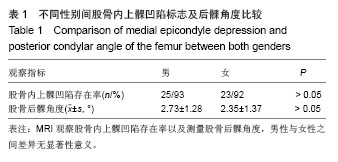| [1]Bijlsma JW, Berenbaum F, Lafeber FP. Osteoarthritis: an update with relevance for clinical practice. Lancet. 2011; 377(9783):2115-2126.
[2]Czurda T, Fennema P, Baumgartner M,et al. The association between component malalignment and post-operative pain following navigation-assisted total knee arthroplasty: results of a cohort/nested case-control study. Knee Surg Sports Traumatol Arthrosc. 2010;18(7):863-869.
[3]Walde TA, Bussert J, Sehmisch S,et al. Optimized functional femoral rotation in navigated total knee arthroplasty considering ligament tension. Knee. 2010;17(6):381-386.
[4]Classen T, Wegner A, Müller RD,et al. Femoral component rotation and Laurin angle after total knee arthroplasty. Acta Orthop Belg. 2010;76(1): 69-73.
[5]Abadie P, Galaud B, Michaut M,et al. Distal femur rotational alignment and patellar subluxation: a CT scanin vivo assessment. Orthop Traumatol Surg Res. 2009;95(4): 267-271.
[6]王平,赵志江,付卫杰,等.人工全膝关节置换术中股骨假体旋转的研究进展[J].中国修复重建外科杂志, 2011,25(9):1140-1144.
[7]洪源,冯建民,何川.全膝关节置换术股骨假体旋转力线研究进 展[J].国际骨科学杂志,2011,32(4):219-221.
[8]戚盈杰,胡月正,吴剑彬,等.全膝关节置换术股骨及胫骨假体旋转定位研究进展[J].国际骨科学杂志,2011,32(4):221-223.
[9]吴昊.全膝关节置换过程中的假体旋转对位[J].中国组织工程研究,2012,16(4):717-722.
[10]Berger RA, Rubash HE, Seel MJ,et al. Determining the rotational alignment of the femoral component in total knee arthroplasty using the epicondylar axis. Clin Orthop Relat Res. 1993;(286): 40-47.
[11]Churchill DL, Incavo SJ, Johnson CC,et al. The transepicondylar axis approximates the optimal flexion axis of the knee. Clin Orthop Relat Res. 1998;(356): 111-118.
[12]Victor J, Van Doninck D, Labey L,et al. A common reference frame for describing rotation of the distal femur: a ct-based kinematic study using cadavers. J Bone Joint Surg (Br). 2009;91(5): 683-690.
[13]Lützner J, Krummenauer F, Wolf C,et al. Computer-assisted and conventional total knee replacement: a comparative, prospective, randomised study with radiological and CT evaluation. J Bone Joint Surg (Br). 2008;90(8): 1039-1044.
[14]孙辉红,陈益光,李晶,等.螺旋CT三维重建技术对股骨后髁角个体化测量的应用研究[J].中国CT和MRI杂志,2012,10(5):92-94.
[15]窦鑫.范海建.张臻.等.多排螺旋CT对股骨标本后髁角的测量及其临床意义[J].浙江临床医学, 2012,14(2):135-137.
[16]臧越,吴舰,孙铁铮.膝关节骨性关节炎患者下肢扭转角度CT评价的临床价值[J].影像诊断与介入放射学,2012,21(4):268-273.
[17]张建雷,陆声,梁金龙,等. 基于连续断层CT扫描与三维重建技术的股骨远端旋转力线的测量[J].中国骨科临床与基础研究杂志,2012,4 (6):411-416.
[18]龙腾河,吕国顺,崔惠勤.磁共振图像测量膝关节置换股骨假体旋转对线[J].中国组织工程研究与临床康复,2011,15(52): 9839-9842.
[19]Hitt K, Shurman JR, Greene K, et al. Anthropometric measurements of the hunman knee: correlation to sizing of current knee arthroplasty systems. J Bone Joint Surg Am. 2003;85-A Suppl 4: 115-122.
[20]Luyckx T, Peeters H, Vandenneucker H, et al. Is adapted measured resection superior to gap-balancing in determining femoral component rotation in total knee replacement? J Bone Joint Surg Br. 2012;94-B:1271-1276.
[21]Oussedik S, Scholes C, Ferguson D, et al. Is Femoral Component Rotation in a TKA Reliably Guided by the Functional Flexion Axis? Clin Orthop Relat Res. 2012;470: 3227-3232.
[22]Amiri S, Wilson DR, Anglin C, et al. Isocentric 3-Dimensional C-Arm Imaging of Component Alignments in Total Knee Arthroplasty With Potential Intraoperative and Postoperative Applications. J Arthroplasty. 2013;28(2):248-254.
[23]Kaipel M, Gergely I, Sinz K,et al. Femoral Rotation in Ligament Balanced Knee Arthroplasty A Prospective Clinical Study. J Arthroplasty. 2013;282:1103-1106.
[24]Koninckx A, Deltour A, Thienpont E. Femoral sizing in total knee arthroplasty is rotation dependant. Knee Surg Sports Traumatol Arthrosc. 2013. Epub ahead of print.
[25]Yoshino N, Takai S,Hirasawa Y, et al. Computed tomography measurement of the surgical and clinical trans epicondylar axis of the distal femur in osteoarthritis. J Arthroplasty. 2001; 16 (4):493-497.
[26]Sun T, Lu H, Hong N ,et al. Bony landmarks and rotational alignment in total knee arthroplasty for Chinese osteoarthritic knees with varus or valgus deformities. J Arthroplasty. 2009; 24(3):427-431.
[27]洪源,冯建民,何川,等.股骨上髁轴与股骨外旋截骨角度的相关性研究[J].中华临床医师杂志:电子版,2013,7(14):6329-6334.
[28]纪小孟,刘皤,刘雅克,等.基于磁共振对股骨远端旋转参照轴线的确定及其临床意义[J]中华关节外科杂志:电子版,2012,6(3): 393-398.
[29]姜侃,吴巧云,巨啸晨.新疆哈萨克族全膝关节置换术(TKA)中股骨远端旋转对线方法的研究[J].新疆医学, 2013,43(9):20-25.
[30]李军,李阳,荆珏华,等.华南地区正常成人股骨远端髁扭转角测量及其临床意义[J].中华关节外科杂志:电子版,2013,7(3):319- 322.
[31]Thomas JH, Le RC, Jack D, et al. MRI analysis for rotation of total knee components. Knee. 2012;19(5):571-575.
[32]Frankie MG, Math K,Giles RS,et al.Anatomy of the epicondyles of the distal femur:MRI analysis of normal knees. J Arthroplasty. 2000;15:354-359.
[33]Won YY, Cui WQ, Baek MH, et al. An Additional Reference Axis for Determining Rotational Alignment of theFemoral Component inTotal Knee Arthroplasty. J Arthroplasty. 2007; 22:1049-1053.
[34]覃承诃,裴国献,罗吉伟.华南地区成人股骨后髁角及髁扭转角的MRI测量[J].南方医科大学学报,2007,27(5):749-750. |

.jpg)